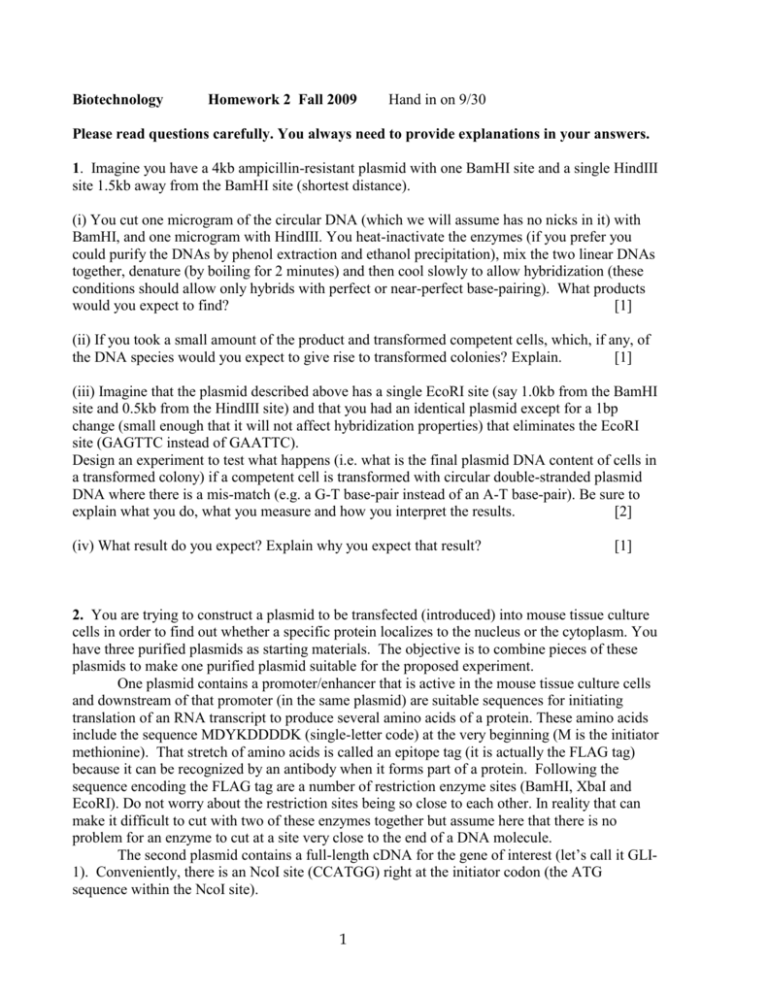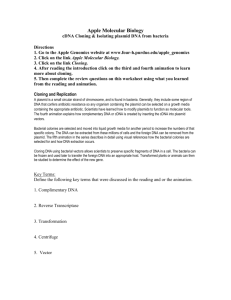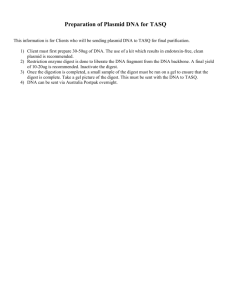Biotechnology Homework 2 Fall 2009 Hand in on 9/30
advertisement

Biotechnology Homework 2 Fall 2009 Hand in on 9/30 Please read questions carefully. You always need to provide explanations in your answers. 1. Imagine you have a 4kb ampicillin-resistant plasmid with one BamHI site and a single HindIII site 1.5kb away from the BamHI site (shortest distance). (i) You cut one microgram of the circular DNA (which we will assume has no nicks in it) with BamHI, and one microgram with HindIII. You heat-inactivate the enzymes (if you prefer you could purify the DNAs by phenol extraction and ethanol precipitation), mix the two linear DNAs together, denature (by boiling for 2 minutes) and then cool slowly to allow hybridization (these conditions should allow only hybrids with perfect or near-perfect base-pairing). What products would you expect to find? [1] (ii) If you took a small amount of the product and transformed competent cells, which, if any, of the DNA species would you expect to give rise to transformed colonies? Explain. [1] (iii) Imagine that the plasmid described above has a single EcoRI site (say 1.0kb from the BamHI site and 0.5kb from the HindIII site) and that you had an identical plasmid except for a 1bp change (small enough that it will not affect hybridization properties) that eliminates the EcoRI site (GAGTTC instead of GAATTC). Design an experiment to test what happens (i.e. what is the final plasmid DNA content of cells in a transformed colony) if a competent cell is transformed with circular double-stranded plasmid DNA where there is a mis-match (e.g. a G-T base-pair instead of an A-T base-pair). Be sure to explain what you do, what you measure and how you interpret the results. [2] (iv) What result do you expect? Explain why you expect that result? [1] 2. You are trying to construct a plasmid to be transfected (introduced) into mouse tissue culture cells in order to find out whether a specific protein localizes to the nucleus or the cytoplasm. You have three purified plasmids as starting materials. The objective is to combine pieces of these plasmids to make one purified plasmid suitable for the proposed experiment. One plasmid contains a promoter/enhancer that is active in the mouse tissue culture cells and downstream of that promoter (in the same plasmid) are suitable sequences for initiating translation of an RNA transcript to produce several amino acids of a protein. These amino acids include the sequence MDYKDDDDK (single-letter code) at the very beginning (M is the initiator methionine). That stretch of amino acids is called an epitope tag (it is actually the FLAG tag) because it can be recognized by an antibody when it forms part of a protein. Following the sequence encoding the FLAG tag are a number of restriction enzyme sites (BamHI, XbaI and EcoRI). Do not worry about the restriction sites being so close to each other. In reality that can make it difficult to cut with two of these enzymes together but assume here that there is no problem for an enzyme to cut at a site very close to the end of a DNA molecule. The second plasmid contains a full-length cDNA for the gene of interest (let’s call it GLI1). Conveniently, there is an NcoI site (CCATGG) right at the initiator codon (the ATG sequence within the NcoI site). 1 The third plasmid includes a region of a different gene that acts, when transcribed, as a signal for the transcript to be cleaved and polyadenylated (which is important for mRNA stability and translation). The signal works if RNA is transcribed in the direction from XbaI to EcoRI. The desired product includes the promoter and FLAG epitope coding sequence from the first plasmid connected to the GLI-1 cDNA (such that the whole GLI-1 protein is translated following the FLAG epitope to make a “tagged” fusion protein) and to the XbaI-EcoRI polyadenylation signal segment. It is not important if there are a few extra amino acids between the FLAG tag and the rest of the normal GLI-1 protein and the success of the experiment does not depend on the nature or length of the 3’ UTR (untranslated region) of the mRNA made in the mouse cells. You can assume that the restriction sites shown do not occur at any additional locations in the plasmids shown and that all of the plasmids have ampicillin-resistance genes. You can use any additional materials (oligos, enzymes etc.) you think appropriate. BamHI cuts between the Gs and NcoI between the Cs in their recognition sequence, on each strand. 2 (i) Describe how you would make the desired plasmid (WITHOUT using PCR) In your answer be sure to make clear (a) the exact sequences of any additional DNAs you use AND the exact sequence in your final construct between the FLAG epitope and the start of the GLI-1 cDNA. [2] (b) steps in the procedure including purifications (explaining why they are necessary or optional) [2] (c) how you will identify a correct product and [1] (d) how you will make sure that the correct product is indeed definitely correct (pointing out the most likely imperfection you may come across). [1] (ii) You have exactly the same objective as in (i) except that now (a) you are allowed to use PCR (b) the first plasmid has the same promoter/enhancer but does not have FLAG epitope sequence; instead there is just a BamHI site followed by an XbaI site and an EcoRI site at that position (just GGATCCATCTAGATCGAATTC from the sequence shown in part (i)) and (c) the second and third plasmids no longer have any of the indicated restriction sites (say because the NcoI site is now TCATGG, the XbaI sites are TCGAGA and the EcoRI site GAGTTC, though the precise reason is not important). How do you make the desired plasmid that will encode GLI-1 with an N-terminal FLAG epitope? Pay attention to the same four issues as described in (i), including specifying the length of any primers used and the location of their binding sites (sites of hybridization) where actual sequences are not known (include sequence in places where it is known). [4] PLEASE START A NEW PAGE IN YOUR ANSWERS TO THE REMAINING QUESTIONS 3 3. As for the human genome and the genomes of several model organisms, the mouse genome has been sequenced (technically, it and others still have some gaps but that is not relevant here) and considerable work has been done predicting and experimentally determining which regions are transcribed and how mRNAs are spliced (although that kind of work is certainly incomplete). (i) You have a particular strain of mouse and want to determine the DNA sequence of a specific region of one gene (and here we can assume the DNA to be tested comes from one mouse and is not expected to be heterozygous at the locus tested- i.e. assume uniform DNA content). You look at the known DNA sequence in that region (for normal mice) and choose two PCR primers to make. You expect to see a band of 1.6kb after PCR amplification but in fact you also see a fairly strong band of 0.9kb. Briefly describe THREE ways you could proceed to your sequencing objective (these can include new materials and further experiments), explaining why each is likely to work or may have a problem. [3] (ii) You look at a different region of the genome and again design a couple of primers. This time, however, you are interested in examining mRNA, so your starting material for an RT-PCR experiment is a preparation of mouse liver RNA (and you forgot to ask exactly how the sample was made). Imagine that after RT-PCR you see a band of 1.4kb and one of 1.1kb. You also performed a control reaction in which everything was the same except that you did not add any reverse transcriptase. What do you think the two PCR products correspond to if, in the control reaction (a) there is only a 1.4kb band? [1] (b) there are no PCR products? [1] 4. Phage lambda can be used as a cloning vector (i) Why does this vector not need to carry an antibiotic resistance gene? [1] (ii) Lambda can act as a lysogen where it integrates into host DNA and is stably inherited thereafter (until induced to excise and undergo a lytic life cycle). Give TWO reasons why it is not practical to use the lysogenic lifestyle of lambda for cloning recombinant molecules (be precise). [2] (iii) To make lambda DNA one infects growing cells with phage, waits a few hours and then spins down cells and recovers the supernatant. Is lambda DNA the only DNA in the supernatant, AND what is the next step in purifying lambda DNA? [1] (iv) When cloning with lambda how do you ensure that a single E.coli contains no more than one type of lambda DNA? [1] (v) If lambda plaques are very dense they can overlap substantially so that any region of a plate might contain two different recombinant lambda molecules. For a single such region (in which you are interested, perhaps because you have identified a cDNA clone by plaque lifts and hybridization to a probe), how can you most easily obtain a pure population of a single phage (the correct cDNA in the example offered)? [1] 5. Budding yeast (Saccharomyces cerevisiae) are in some ways similar to E.coli- DNAs can be introduced reasonably efficiently into cells by special treatment of the cells (and generally only single molecules are taken up), circular yeast plasmids can be maintained at high copy number and used as vectors much as for E.coli and yeast can be spread on plates of defined nutrient 4 composition to select for growth into distinct colonies only of yeast cells that have taken up a plasmid (basically, instead of antibiotic resistance genes on a plasmid, the plasmid contains a gene for growing on plates lacking, for example, tryptophan; the yeast need this gene because the host strain deliberately has the normal gene eliminated). So, in other words, one could clone DNA in yeast plasmids just for the sake of isolating pure DNAs but this is rarely if ever done (YACS are an exception, but are not really plasmids) because all of these procedures are much slower and less efficient than in E. coli. Many researchers are, however, interested in exploring gene functions in yeast and the DNA manipulations cited above are very useful for those objectives. For example, one could introduce into yeast a yeast plasmid (capable of replication and stable inheritance in yeast) that contained an active yeast promoter linked to a yeast cDNA in order to complement a yeast strain in which a specific gene (corresponding to the cDNA) was inactive. That type of complementation or rescue is generally successful (even though the cDNA is often not expressed at normal levels). Yeast were used many years ago to identify mutations that prevented passage through the cell cycle. Most of these mutations were identified as temperature-sensitive, meaning that cells could grow normally at a low, permissive temperature but arrested growth (in fact at a specific point in the cell cycle) at a high, restrictive temperature. The mutations were induced by chemical mutagens and so were at unknown locations. If you have a specific temperature-sensitive cell cycle mutant of yeast how can you EFFICIENTLY identify the gene that is affected (using some of the hints given in the introduction about complementation- not by complete genome sequencing, which was not possible at the time cell cycle mutants were first isolated)? Describe all of the essential steps in outline. [3] 6. Around thirty years ago some researchers hypothesized that human cancers were being driven by mutations that cause certain genes to be more active than usual (oncogenes). Researchers also knew that many cell types, including fibroblasts, will grow on a plastic dish in culture until a monolayer forms, whereas cancer cells continue to grow, piling up on each other. Thus, if a dish contains tens of millions of normal cells plus a few cancer-like cells each of the latter cells will make themselves visible by forming a localized pile-up of cells (a focus), which can be transferred to a new dish to expand just that population of cells (a little bit like cloning in E. coliexcept that a clone/focus is identified by overgrowth rather than just growth). Hence, the idea was to start with DNA from a human cancer cell and use a normal mouse fibroblast cell to identify human oncogenes. The most common way to introduce DNA into mouse cells in culture such that the DNA is subsequently maintained is to transfect linear DNA. Some cells will take up no DNA. Many will take up DNA but will not integrate it into their chromosomes and will therefore lose it after a few days, but a few cells will take up and integrate DNA. Unlike E.coli and yeast, however, those cells will generally take up and maintain hundreds or thousands of DNA molecules. In principle, how can an individual oncogene be defined using this approach (There may be two or three related, equally good approaches- the actual approach that was used depended in its final steps on the fact that any large segment of human DNA contains some repeated sequences that can be identified by hybridization, but are absent from mouse DNA)? [3] 5







